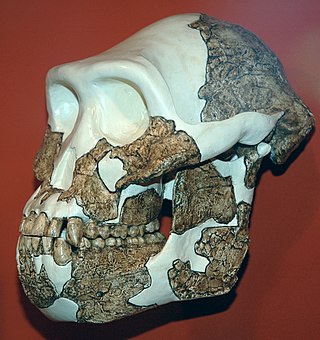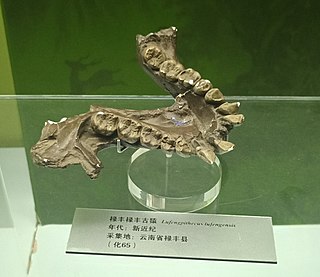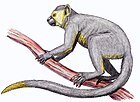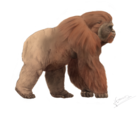
Ponginae, also known as the Asian hominids, is a subfamily in the family Hominidae. Once a diverse lineage of Eurasian apes, the subfamily has only one extant genus, Pongo (orangutans), which contains three extant species; the Sumatran orangutan, the Tapanuli orangutan and the Bornean orangutan. All three species are listed as critically endangered by the International Union for Conservation of Nature (IUCN).

Pierolapithecus catalaunicus is an extinct species of primate which lived around 12.5-13 million years ago during the Miocene in what is now Hostalets de Pierola, Catalonia, Spain. Some researchers believe that it is a candidate for common ancestor to the great ape clade, or is at least closer than any previous fossil discovery. Others suggest it being a pongine, or a dryopith. On 16 October 2023, scientists reported the facial reconstruction of the great ape.

Proconsul is an extinct genus of primates that existed from 21 to 17 million years ago during the Miocene epoch. Fossil remains are present in Eastern Africa, including Kenya and Uganda. Four species have been classified to date: P. africanus, P. gitongai, P. major and P. meswae. The four species differ mainly in body size. Environmental reconstructions for the Early Miocene Proconsul sites are still tentative and range from forested environments to more open, arid grasslands.

Australopithecus anamensis is a hominin species that lived approximately between 4.3 and 3.8 million years ago and is the oldest known Australopithecus species, living during the Plio-Pleistocene era.
The Omo remains are a collection of hominin bones discovered between 1967 and 1974 at the Omo Kibish sites near the Omo River, in Omo National Park in south-western Ethiopia. The bones were recovered by a scientific team from the Kenya National Museums directed by Richard Leakey and others. The remains from Kamoya's Hominid Site (KHS) were called Omo I and those from Paul I. Abell's Hominid Site (PHS) were called Omo II.

Afropithecus is a genus of Miocene hominoid with the sole species Afropithecus turkanensis, it was excavated from a small site near Lake Turkana called Kalodirr in northern Kenya in 1986 and named by Richard Leakey and Meave Leakey. The estimated age of Afropithecus is between 16 and 18 million years old, which was determined with radiometric dating techniques and the geological studies conducted by Broschetto and Brown from the University of Utah. In total there are 46 recovered specimens from Kalodirr relating to Afropithecus consisting of cranial, mandible, dentition and post-cranial remains. The type specimen of Afropithecus turkanensis is KNM-WK 16999.

Proconsulidae is an early family of primates that lived during the Miocene epoch in Kenya, and was restricted to Africa. Members of the family have a mixture of Old World monkey and ape characteristics, so the placement in the ape superfamily Hominoidea is tentative; some scientists place Proconsulidae outside of Hominoidea in a separately superfamily Proconsuloidea, before the split of the apes and Old World monkeys.
David Pilbeam is the Henry Ford II Professor of the Social Sciences at Harvard University and curator of paleoanthropology at the Peabody Museum of Archaeology and Ethnology. He is a member of the National Academy of Sciences. He received his Ph.D. from Yale University.
Oligopithecidae is an extinct basal Catarrhine family from the late Eocene of Egypt as sister of the rest of the Catarrhines. Its members were probably insectivorous, due to their simple molars and cusp arrangement.

Lufengpithecus is an extinct genus of ape, known from the Late Miocene of East Asia. It is known from thousands of dental remains and a few skulls and probably weighed about 50 kg (110 lb). It contains three species: L. lufengensis, L. hudienensis and L. keiyuanensis. Lufengpithecus lufengensis is from the Late Miocene found in China, named after the Lufeng site and dated around 6.2 Ma. Lufengpithecus is either thought to be the sister group to Ponginae, or the sister to the clade containing Ponginae and Homininae.
Kamoyapithecus was a primate that lived in Africa during the late Oligocene period, about 24.2-27.5 million years ago. First found in 1948 as part of a University of California, Berkeley expedition, it was at first thought to be under a form of Proconsul by C.T. Madden in 1980, but after a re-examination by Meave Leakey and associates later, the fossils were moved under a new genus Kamoyapithecus, named after the renowned fossil finder Kamoya Kimeu. The genus is represented by only one species, K. hamiltoni.

Graecopithecus is an extinct genus of hominid that lived in southeast Europe during the late Miocene around 7.2 million years ago. Originally identified by a single lower jaw bone bearing teeth found in Pyrgos Vasilissis, Athens, Greece, in 1944, other teeth were discovered from Azmaka quarry in Bulgaria in 2012. With only little and badly preserved materials to reveal its nature, it is considered as "the most poorly known European Miocene hominoids." The creature was popularly nicknamed 'El Graeco' by scientists.

The evolutionary history of the primates can be traced back 57-90 million years. One of the oldest known primate-like mammal species, Plesiadapis, came from North America; another, Archicebus, came from China. Other similar basal primates were widespread in Eurasia and Africa during the tropical conditions of the Paleocene and Eocene. Purgatorius is the genus of the four extinct species believed to be the earliest example of a primate or a proto-primate, a primatomorph precursor to the Plesiadapiformes, dating to as old as 66 million years ago.
The phylogenetic split of Hominidae into the subfamilies Homininae and Ponginae is dated to the middle Miocene, roughly 18 to 14 million years ago. This split is also referenced as the "orangutan–human last common ancestor" by Jeffrey H. Schwartz, professor of anthropology at the University of Pittsburgh School of Arts and Sciences, and John Grehan, director of science at the Buffalo Museum.

Pliobates cataloniae is a primate from 11.6 million years ago, during the Iberian Miocene. Originally described as a species of stem-ape that was found to be the sister taxon to gibbons and great apes like humans, it was subsequently reinterpreted as a non-ape catarrhine belonging to the group Crouzeliidae within the superfamily Pliopithecoidea on the basis of discovery of new dental remains with crouzeliid synapomorphies.

Ekembo is an early ape (hominoid) genus found in 17- to 20-million-year-old sediments from the Miocene epoch. Specimens have been found at sites around the ancient Kisingiri volcano in Kenya on Rusinga Island and Mfangano Island in Lake Victoria. The name Ekembo is Suba for "ape" or "monkey".

Pliopithecoidea is an extinct superfamily of catarrhine primates that inhabited Asia and Europe during the Miocene. Although they were once a widespread and diverse group of primates, the pliopithecoids have no living descendants.
Propliopithecoidea is a superfamily of catarrhine primates that inhabited Africa and the Arabian Peninsula during the Early Oligocene about 32 to 29 million years ago. Fossils have been found in Egypt, Oman and Angola. They are one of the earliest known families of catarrhines. They have a number of features in common with extant catarrhines, but also features that are primitive and not found in later catarrhine families.
The Nyanzapithecinae or Nyanzapithecines are a subfamily of extinct Dendropithecidae as sister of Simiolus. The group contains Rangwapithecus, Turkanapithecus, Rukwapithecus, Oreopithecus, and Nyanzapithecus. In the following tree the internal structure of Nyanzapithecinae of Nengo et al. is followed.

Nyanzapithecus is an extinct genus of primate from the Middle Miocene of Maboko Island, Nyanza Province, Kenya. This genus is known from four species. It had an average body mass of around 10 kg (22 lb).
















